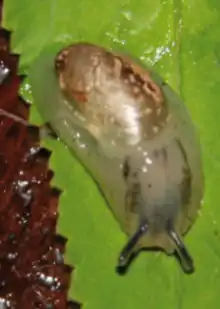| Amphibulima browni | |
|---|---|
 | |
| A live individual of Amphibulima browni | |
| Scientific classification | |
| Domain: | Eukaryota |
| Kingdom: | Animalia |
| Phylum: | Mollusca |
| Class: | Gastropoda |
| Subclass: | Heterobranchia |
| Order: | Stylommatophora |
| Family: | Amphibulimidae |
| Genus: | Amphibulima |
| Species: | A. browni |
| Binomial name | |
| Amphibulima browni | |
Amphibulima browni is a species of air-breathing land snail, a terrestrial pulmonate gastropod mollusk in the family Amphibulimidae.
This rare tropical land snail is endemic to the West Indian island of Dominica. The snail has been seen only very rarely since it was first discovered in the late 19th century, and it may eventually be listed as an endangered species. The shell of this snail is oblong and thin, but not fragile, and it has a large aperture.
Distribution
Amphibulima browni is endemic to the West Indian island of Dominica.[2] The type locality is Dominica, the altitude 330 m, "on bananas".[1]
The status of this species, which is one of three species of Amphibulima on Dominica, has been somewhat doubtful for a long period, since this taxon has not been reported since its original description.[2] The collection of a few live specimens during the recent surveys in the 2000s confirmed its presence, and although it appears rare, it seems to be less restricted in distribution than Amphibulima pardalina.[2]
Amphibulima browni is likely to meet the IUCN-criteria for listing as Endangered species.[2]
Description
Amphibulima browni was firstly collected by biologist A. D. Brown and it was originally described by an American malacologist Henry Augustus Pilsbry in 1899.[1]

The shell is oblong, thin, but not elastic or fragile, corneous-olivaceous, with numerous irregularly scattered reddish dots. The surface is somewhat wrinkled with growth-striae and showing numerous very low but coarse irregular spirals. The shell has 2½ whorls. The apex is decidedly raised. The suture of the last half whorl is rapidly descending. The spire is rather slender and its length contained from 4½ to 4¾ times in that of the shell.[1]
The aperture is large, irregularly oblong. The outer lip is somewhat blunt, strongly arcuate above, retracted or waved backward at the position of the slight "shoulder" and somewhat effuse below. The columella is arcuate and thin.[1]
The height of the shell is from 18.5 to 19 mm.[1] The width of the shell is from 10 to 10.5 mm.[1] The height of the aperture is 14.7–15 mm.[1] The height of the spire is 3.8-4.3 mm.[1]
 Drawing of apertural view. |
 Drawing of lateral view. |
 Drawing of abapertural view. |
References
This article incorporates public domain text from the reference [1] and CC-BY-3.0 text from the reference.[2]
- 1 2 3 4 5 6 7 8 9 10 Pilsbry H. A. (1899). "American Bulimulidae: North American and Antillean Drymaeus, Leiostracus, Orthalicinae and Amphibuliminae". Manual of Conchology (2)12: i-iii, 1-258, pls 1-64. Amphibulima browni is on the page 238-239, plate 61, figs 28-31.
- 1 2 3 4 5 Robinson D. G., Hovestadt A., Fields A. & Breure A. S. H. (July 2009). "The land Mollusca of Dominica (Lesser Antilles), with notes on some enigmatic or rare species". Zoologische Mededelingen 83 http://www.zoologischemededelingen.nl/83/nr03/a13 Archived 2011-10-07 at the Wayback Machine
External links
 Media related to Amphibulima browni at Wikimedia Commons
Media related to Amphibulima browni at Wikimedia Commons